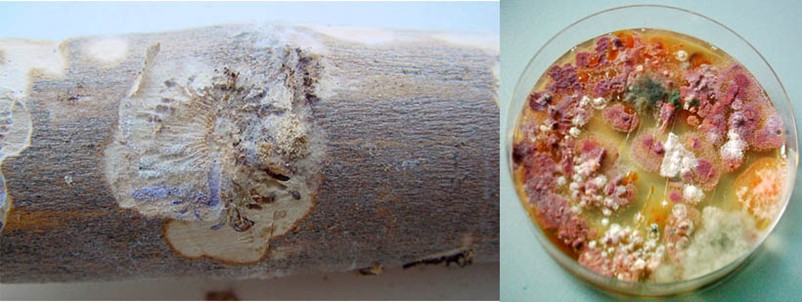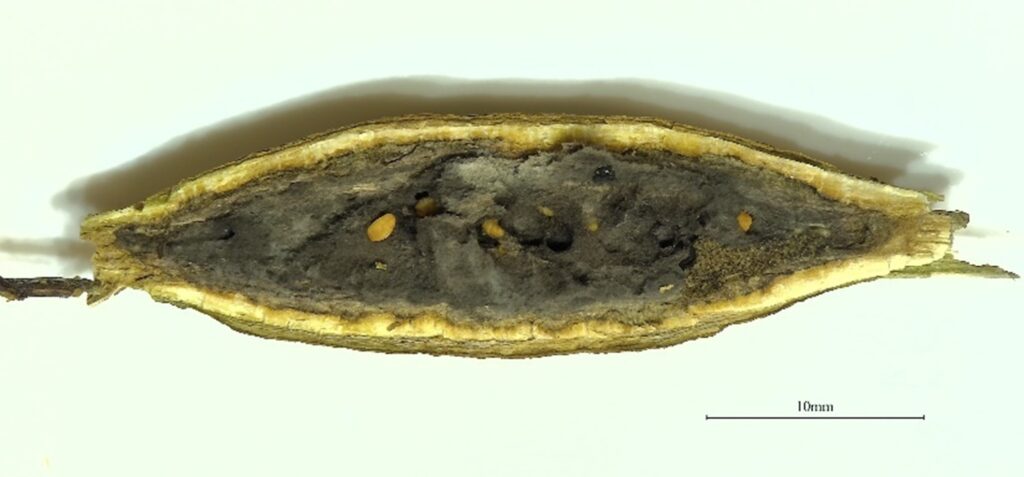Microbial symbioses of herbivorous insects
A significant portion of insects feed on plant matter and play important roles in natural ecosystems and agriculture. These herbivorous insects inhabit environments that are nutrient-poor but rich in toxic substances. They overcome these limitations through symbiosis with bacteria and fungi. These symbionts help break down plant material, provide essential nutrients, and detoxify the substrate. Many of these symbionts are also important plant pathogens. Symbionts are found inside the insect bodies or on their surroundings. The most advanced form of symbiosis with fungi is called nutritional symbiosis, where insects actively carry and cultivate their nutritional symbionts. This interaction is known as fungal farming and is similar to our relationship with agricultural crops. Our team studies the symbionts of caterpillars (Lepidoptera), ambrosia gall midges (Diptera, Cecidomyiidae), woodwasps (Hymenoptera, Siricidae), bark beetles (Curculionidae, Scolytinae), pinhole borers (Curculionidae, Platypodinae), and termites (Isoptera, Termitoidae).

Caterpillars of butterflies
Within caterpillars of butterflies, we know various feeding strategies, including monophagy and polyphagy, with narrow and broad host plant ranges, respectively. We are testing the hypothesis that the breadth of the host range is influenced by microbes and their detoxification capabilities. Additionally, we have demonstrated that the gut microbiota of caterpillars is partially influenced by the caterpillar species itself, not just by diet. This indicates the presence of symbiotic relationships and suggests numerous interactions.

Bark and ambrosia beetles
Bark and ambrosia beetles are important components offorest ecosystems, and several species are significant forestry pests. Ourlong-term goal is to gain comprehensive knowledge about the little-knownsymbiosis of the fungal genus Geosmithia, its evolutionary history, diversity, and environmental interactions. We have described the gut microbial communities of the spruce bark beetle, Ips typographus, for the first time andproposed the ecological roles of the main symbiotic partners. These roles arebeing verified using a metatranscriptomic approach. Recently, we have described dozens of new microbial species, including the phytopathogenic fungi Geosmithia morbida and Ophiostoma juglandis, which are transmitted by invasive bark beetles that attack walnut trees. We are also studying the role of microbial secondary metabolites of symbionts in the entiresymbiosis.
Woodwasps
Woodwasps attack tree wood, and some invasive species are serious forest pests. These wasps live in nutritional symbiosis with fungi, which themselves have economic significance as wood destroyers. Our team has characterized the diversity, host specificity, and taxonomy of their fungal symbionts from the genera Daldinia and Hypoxylon for the first time. Our further research focuses on the secondary metabolites of the symbionts from the genus Amylostereum.
Ambrosia gall midges
Ambrosia gall midges form galls in which they cultivate their nutritional symbiont, the fungus Botryosphaeria dothidea. For the first time, we have described the whole microbial communities of both the gall midges and the galls. We are studying how this fungus interacts with the host plant and the insect.

The main results are summarized in the following papers, which also highlight the extent of our international collaboration, involving teams from Spain, Poland, China, and the USA.
- Veselská T, Skelton J, Kostovčík M, Hulcr J, Baldrian P, Chudíčková M, Cajthaml T, Vojtová T, Garcia-Fraile P, Kolařík M (2019) Adaptive traits of bark and ambrosia beetle-associated fungi. Fungal Ecology 41: 165-176.
- Strzałka B, Kolařík M, Jankowiak R (2021) Geosmithia associated with hardwood-infesting bark and ambrosia beetles, with the description of three new species from Poland. Antonie van Leeuwenhoek 114: 169-194.
- Saati-Santamaría Z, Rivas R, Kolařik M, García-Fraile P (2021) A new perspective of Pseudomonas—host interactions: distribution and potential ecological functions of the genus Pseudomonas within the bark beetle holobiont. Biology 10: 164.
- Šigut M, Pyszko P, Šigutová H, Višňovská D, Kostovčík M, Kotásková N, Dorňák O, Kolařík M, Drozd P (2022) Fungi are more transient than bacteria in caterpillar gut microbiomes. Scientific Reports 12:15552.
- Li Y, Bateman C, Skelton J, Wang B, Black A, Huang Y-T, Gonzalez A, Jusino MA, Nolen ZJ, Freeman S. (2022) Preinvasion assessment of exotic bark beetle-vectored fungi to detect tree-killing pathogens. Phytopathology 112: 261-270.
- Šigutová H, Šigut M, Pyszko P, Kostovčík M, Kolařík M, Drozd P. (2023) Seasonal shifts in bacterial and fungal microbiomes of leaves and associated leaf-mining larvae reveal persistence of core taxa regardless of diet. Microbiology Spectrum:e03160-03122.
- Kolařík M, Hulcr J. 2023. Geosmithia—widespread and abundant but long ignored bark beetle symbionts. Mycological progress 22: 32.
- Cheng T, Veselská T, Křížková B, Švec K, Havlíček V, Stadler M, Kolařík M. (2023) Insight into the genomes of dominant yeast symbionts of European spruce bark beetle, Ips typographus. Frontiers in microbiology 14: 930.
- Veselská T, Švec K, Kostovčík M, Peral-Aranega E, Garcia-Fraile P, Křížková B, Havlíček V, Saati-Santamaría Z, Kolařík M. (2023) Proportions of taxa belonging to the gut core microbiome change throughout the life cycle and season of the bark beetle Ips typographus. FEMS Microbiol Ecol. 99(8):fiad072.
- Šigutová H, Pyszko P, Šigut M, Czajová K, Kostovčík M, Kolařík M, et al. (2024) Concentration-dependent effect of plant secondary metabolites on bacterial and fungal microbiomes in caterpillar guts. Microbiology Spectrum.;12:e02994-23.
- Pyszko P, Šigutová H, Kolařík M, Kostovčík M, Ševčík J, Šigut M, et al. (2024) Mycobiomes of two distinct clades of ambrosia gall midges (Diptera: Cecidomyiidae) are species-specific in larvae but similar in nutritive mycelia. Microbiology Spectrum.;12:e02830-23.
- Májek, T., Kolařík, M., Milenković, I. et al. New Ophiostoma species associated with Dryocoetes himalayensis and decline of Juglans regia in Czechia. J Plant Pathol (2024).